
Vol. 6, No.9, September 2010 |
 Printer-Friendly PDF Version Printer-Friendly PDF Version |
Advisory Board Meets in Gainesville
The Florida SART Advisory Board met at 10:00 a.m. on Wednesday September 1 at the Florida Farm Bureau building in Gainesville. Minutes are posted on the SART web site at www.flsart.org/SART/login - scroll down the page and double-click on “Advisory Board Meeting Minutes (09/01/2010).”
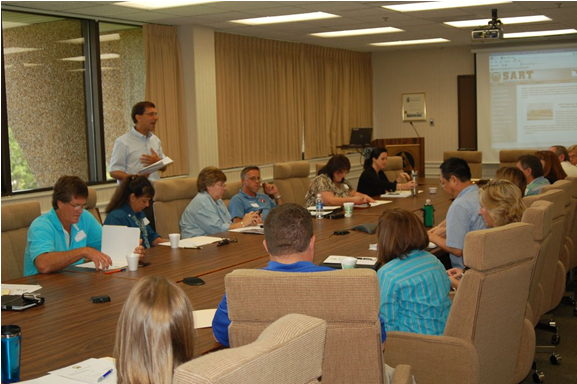 Art Johnstone, Director, Office of Agricultural Emergency Preparedness, FDACS, addresses funding, staffing and other issues involving future SART initiatives.
Art Johnstone, Director, Office of Agricultural Emergency Preparedness, FDACS, addresses funding, staffing and other issues involving future SART initiatives.Highlights of the meeting which was chaired by UF/IFAS’ Joan Dusky and co-chaired by David Perry, FDACs, are available in greater depth in the Minutes:
 A presentation by Tom Ostertag , FWC , regarding the FWC response and continuing responsibilities for the Gulf Oil Spill.
A presentation by Tom Ostertag , FWC , regarding the FWC response and continuing responsibilities for the Gulf Oil Spill.- A report by Connie Brooks about the continuing development of the Florida State Animal Response Coalition (FSARC).
- With help from HSUS volunteers began the program in 1996 to assist emergency managers with animal issues, open pet-friendly shelters and educate the public.
- SARC organizes through local DART teams comprised of volunteers who must be trained for their role.
- SARC deploys and operates under FEMA’s ICS system (100/200 level courses and NIMS 700).
- The Introduction of New Board Members: Dean Wright for the Florida Feed Assn., Connie Brooks for FSARC, Jennifer Chatfield for FDOH and Linda McAbee for the Florida Veterinary Technician Assn. Their agencies are profiled below. Several groups were deleted (or consolidated) including the Disaster Animal Response Team (DART), USDA’s Rural Development and Natural Resource Conservation Service, and from USDA/APHIS-VS-Aquaculture.
- Art Johnstone, FDACS, Office of Agricultural Emergency Preparedness, reported on SART funding and personnel for 2011 and beyond.
- Joe Kight, FDACS, ESF-17 ECO, summarized to-date plans for the statewide 2011 Planning Meeting: February 28 – March 2 at the Altamonte Springs/Orlando North Hilton.
- Jiannong Xin, UF/IFAS IT, reviewed the changes and improvements to the Florida SART web site at www.flsart.org.
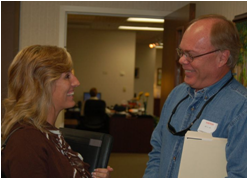 Jennifer Chatfield, DOH, and John Burkett, FDACS, discuss WIFSS educational courses.
Jennifer Chatfield, DOH, and John Burkett, FDACS, discuss WIFSS educational courses.
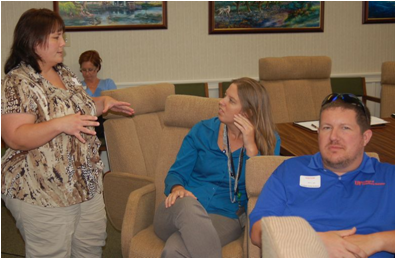
| Linda McAbee, FL Vet Tech Assn. feeds a baby opossum rescued on the highway. | Kim Duffiney, USDA/APHIS (left) discusses SART issues with Catherine Marzolf, USDA/APHIS-PPQ. In the background, Linda McAbee, and to the right John Haven, Director of the UF School of Veterinary Medicine. |
Profile: New Members on SART Advisory Board
Who is a SART partner?
"A stakeholder who has resources that can be made available in an emergency."
Florida ESF-17 Joe Kight, FDACS-DPI
Florida Fruit & Vegetable Association www.ffva.com
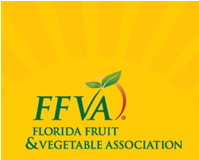
FFVA is a non-profit agricultural trade organization whose mission is to enhance the business and competitive environment for producing and marketing fruits, vegetables and other crops. Members have access to a team of the industry's leading experts on crop protection, labor, water management, government relations, marketing and communication.
FFVA manages and/or owns subsidiary companies involved in supplying labor, administering pesticide regulations and providing workers' compensation insurance.
Florida Feed Association www.floridafeed.com

FFA (not to be confused with Future Farmers of America) is a non-profit organization designed to keep members informed about issues affecting feed manufacturers, suppliers and related firms.
FFA encourages development of friendly relations between all segments of the feed and related industries, such as transport, packaging, equipment, marketing, insurance and laboratory analysis.
The association has an active legislative committee which it feels is one of the most important benefits of membership - and one of the association's most important functions – to monitor and initiate legislation and to prevent harmful laws from being enacted.
Florida Veterinary Technician Association http://thefvta.net
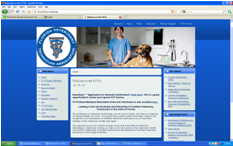
The FVTA is a non-profit association representing more than 600 veterinarian technicians working in private practice, corporate America, government, industry, academia and zoos. FVTA is a collective voice for members and for the career promoting “the advancement and fellowship” of veterinary technicians.
Its mission is: “Improve, encourage and support the development of veterinary technicians by promoting professionalism, ethical behavior, education and public awareness.”
Florida State Animal Response Coalition (Through Bay Area Dart: see www.bayareadart.org/newsletters/2010-03.pdf)
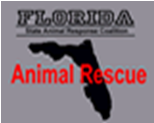
Bay Area DART, along with the University of Florida VETS team, Sumter DART and SART, is proud to be on the forefront of Animal Disaster Response. The team is in the final stages of rolling out the basic training curriculum for all responders within the state. FLSARC certification will enable the state Emergency Operations Center to quickly identify and call upon qualified animal response resources in a disaster. FLSARC hopes to be the model for this certification system nationwide.
Florida Department of Health www.doh.state.fl.us/

The role of public health is to promote and protect the health and safety of all Floridians. According to DOH, they accomplish this mission by: identifying health risks, maintaining a safe and healthful environment; detecting, investigating and preventing the spread of disease; promoting healthy lifestyles; providing primary care for individuals with limited access to such care from the private sector; and ensuring that health care practitioners meet the requirements for providing adequate care; and informing the public on health issues.
Florida's public health and related agencies take on three main health roles: protection, healthy living promotion and disease prevention, and treatment.
[top]
Update: 2011 Florida SART Planning Meeting
Registration for the 2011 SART Planning Meeting will begin shortly. The Planning Meeting will be held February 28 – March 2, 2011 at the Altamonte Springs –Orlando North Hilton.
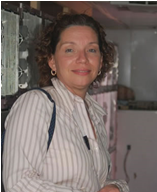

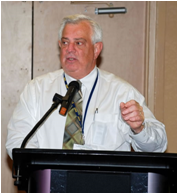 Daisy Harsch Joe Kight Tim Manning
Daisy Harsch Joe Kight Tim Manning
1.Room rates for conference attendees are $93/per night.
2.There is no event fee for registered participants, but you must register at http://flsart.org/BuildingABetterTeam and book your room before January 28, 2011 to be eligible for the group rate.
3.Conference attendees are invited to a light fare reception the evening of February 28. Complimentary breakfasts will be served on March 1 and 2. Lunch is complimentary on March 1 during an awards ceremony.
4.Generous sponsorships have been approved from ASPCA ($5,000) and Florida Farm Credit ($1,000). Other sponsorships are pending.
Tentative Agenda
Monday February 28
1:00 Welcome - Dr. Thomas Holt, State Veterinarian
- Afternoon
- USDA/APHIS - Animal Care
- NASAAEP Report and Update
- Division of Emergency Management - Mr. Dave Halstead
- FACA - Paul Studivant
- County Panel: Issues and Concerns
- Palm Beach, Manatee, Orange, Monroe, Franklin
- Evening
- SART Attendee Mixer
Tuesday March 1
- Morning
- Problem-solving Working Groups
- #1 - Search and Rescue
- #2 - Training Needs
- #3 - Transportation and Sheltering
- Awards Luncheon
- Afternoon
- Field training
- #1 - Large Animal Technical Rescue
- #2 - Animal Emergency Care
- #3 - Accessing SART State and Regional Assets
Wednesday March 2
- Morning
- Memorandum of Understanding between FVMA and FDACS
- Florida SARC Report and Update
- FADD
- Group Reports and Responses
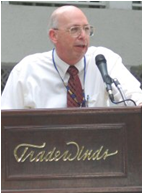
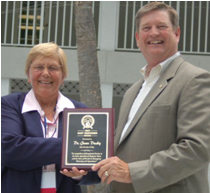
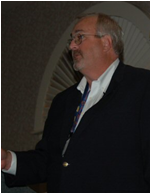 Thomas Holt Joan Dusky & Charles Bronson Craig Fugate
Thomas Holt Joan Dusky & Charles Bronson Craig Fugate Questions may be directed to either Michael Turner(850)410-6761 (turnerm@doacs.state.fl.us) or Joe Kight (kightj@doacs.state.fl.us). A Florida green hotel and conference center, the Hilton Orlando/Altamonte Springs has a web site at http://www1.hilton.com/en_US/hi/hotel/ALTAHHF-Hilton-Orlando-Altamonte-Springs-Florida/index.do
[top]
Florida State Animal Response Coalition
Connie Brooks reported on the development of the new Florida State Animal Response Coalition or FSARC at the most recent SART Advisory Board meeting. A not-for-profit organization, FSARC is now an official SART partner for animal emergency response in Florida and has a dozen trained teams available for deployment under the auspices of state and local emergency management utilizing the principles of the Incident Command System (ICS).

A lot of planners and elected officials don’t have a handle on how big the evacuation problem could be, Brooks noted in her talk to the Advisory Board. In her area, for example, there are 440,000 registered cats and dogs, but the estimate of the total pet population is closer to a million and Bay Area DART (Disaster Animal Response Team) only has 350 volunteer members.
Brooks said the deployed DART teams leaned a great deal while working with effects of the oil spill on animals in Florida. As an example, she mentioned that when transporting wild gannets – which needed cleaning from the oil – the species needed darkness and quiet. Thus the teams did not play the radio or talk on their cell phone inside transport vehicles.
Brooks is president of FSARC and other members of the Board of Directors are Ronnie Graves, Laura Bevan, Consie von Gontard and their web master Christopher Herscha. FSARC “survives on donations,” Brooks says and tax deductible donations can be sent to:
Florida State Animal Response Coalition
680 E. Southland Avenue
Bushnell, FL 33513
For information about how to get involved, contact Connie Brooks (727) 420-3731 connie@spcatampabay.org, Pam Burns (727) 517-1170 pamburnssarc@gmail.com or Ronnie Graves (352) 793-4477 ronnie@prostheticsresearch.com.
[top]
ADA "Service Animal" Definition to Change
It looks like the definition of a “service animal” will change. A final rule is expected in the Federal Register soon and the effective date will be February 2011:
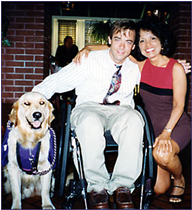 Photo: AssistanceDogsHawaii.org
Photo: AssistanceDogsHawaii.orgService animal: any dog individually trained to work or perform tasks for an individual with a disability (physical, sensory, psychiatric, intellectual or mental). Other species –wild or domestic, trained or untrained – are not service animals.
Tasks performed must be directly related to the handler’s disability:
- assisting sight impaired individuals with navigation,
- alerting hearing impaired individuals to people or sounds,
- providing non-violent protection or rescue work,
- pulling a wheelchair,
- assisting during a seizure,
- alerting individuals to the presence of allergens,
- retrieving items such as medicine or the telephone,
- providing physical support with balance and stability and
- helping mentally impaired persons prevent impulsive or destructive behavior.
The crime deterrent effects or emotional support of an animal’s presence do not qualify.
Key changes include:
1. Only dogs will be recognized as service animals.
2. They must be leashed or harnessed except when performing tasks where tethering would interfere.
3. They are exempt from breed bans as well as size and weight limitations.
4. Though not considered service animals, businesses are generally required to accommodate miniature horses (under specific conditions)!
Liz Serca, Coordinator for Emergency Management, Texas Department of Agriculture, provided key links to fact sheets for further reading “although not every issue necessarily arises in the emergency management context:”
http://www.ada.gov/regs2010/factsheets/title2_factsheet.html and http://www.ada.gov/regs2010/factsheets/title3_factsheet.html.
[top]
Secure Transport of Animal Carcasses
 Photo: USDA/APHIS
Photo: USDA/APHISThe transportation and disposal of animal carcasses after a disaster is an issue for responders. When David Perry and teams from Florida assisted in Texas following the landfall, he mentioned that thousands of large animal carcasses were strewn over the landscape. The larger the disaster the greater the problem and if they are infected with a disease, the problem gets complicated.
USDA/APHIS has developed an online training module for poultry affected by Avian Influenza called “Procedures for Secure Transportation of AI-Infected Poultry Carcasses.” It covers personal protective equipment, how to organize a disposal unit, and correct loading and unloading procedures, and more. The training module is available at www.aphis.usda.gov/emergency_response/
tools/transportation/htdocs/index.html
A tri-fold brochure that summarizes the information is also available at www.aphis.usda.gov/emergency_response/downloads/tools/Secure Transportation Job Aid.pdf.
[top]
National Preparedness Month
What is the one thing that helps responders most? It must be citizens taking responsibility for their own safety: by developing an emergency plan and sharing it with family and friends, taking training classes that are appropriate to their needs, and perhaps evacuating early…when requested.
According to Dr. Carol Lehtola’s “Safety News & Notes,” an on line publication of UF/IFAS (www.flagsafe.ufl.edu/snn/snn-10-09.html), September is National Preparedness Month and the Cooperative Extension Service, through the Extension Disaster Education Network (EDEN), is a partner in this seventh annual campaign. National Preparedness Month materials are available through the EDEN Web site or the main NPM site.
Carol Lehtola, incidentally, is retiring this month and thus September Safety News & Notes is her final issue. We wish her well – broad horizons and brilliant sunrises.

One thing of interest for SART Sentinel readers would be that when I graduated with a BS in Agricultural Engineering (South Dakota State ‘73) with a specialty in soil and water conservation, I certainly never envisioned that someday I would be involved with such things as agroterrorism and other agricultural disaster issues. As an agricultural safety specialist I have had a great opportunity to ‘spread the word’ about the importance of safety in agriculture. It has been rewarding to see former students feel empowered about being able to do something about safety in their workplace or on their own family farm.
This career has demonstrated the ‘ripple’ effect and the differences that people can make. One example that I had documented and wrote an article about was the experience I had teaching a video-based course at Iowa State Univ. Sixty-three adult off-campus people took that course – when they came to campus at the end of the term to give presentations of their term projects – it was estimated that these 63 people had impacted at least 2,000 others with their projects. Some had put on a day-camp for kids, agribusiness people added safety equipment to their inventory, ag loan officers sent safety kits to their clientele, etc. It was exciting to see those things take place. Some of those people, on their farms, still are involved with some form of safety day for area kids – and it is now 20 years later.
I’m moving on to write a cookbook or two, make some quilts for a granddaughter due in December, and maybe even be able to make room to get my car in the garage again!
Be Aware!
Be Alert!
Be Alive!
Carol Lehtola, PhD
[top]
NASAAEP Sponsors Learning Opportunities
EMAC Webinar
NASAAEP is hosting a “webinar” titled Animal Resources and Emergency Management Assistance Compact (EMAC) on September 22 from 2:00 to 3:00 pm EST.
“Please join us for this presentation,” writes Liz Serca, NASAAEP Vice President and Coordinator for Emergency Management for the Texas Dept. of Agriculture. “You must register to participate, so please visit this gotomeeting link: https://www2.gotomeeting.com/register/582245443. After registering, you will receive a confirmation email containing information about joining the Webinar.
What is a “Webinar?” Web conferencing used to conduct live meetings, training, or presentations via the Internet. In a web conference, each participant sits at his or her own computer and is connected to other participants via the internet.
In an emergency, animal response is a critical issue. The Emergency Management Assistance Compact (EMAC) can help access Animal Response Teams, National Animal Rescue and Sheltering Coalition (NARSC) members, and other animal welfare/disaster response organizations.
 Old dogs learning new tricks. Gary Painter observes as Tim Manning checks data during the 2009 SART Planning Meeting.
Old dogs learning new tricks. Gary Painter observes as Tim Manning checks data during the 2009 SART Planning Meeting.This 1-hour Webinar focuses on deployment of non-governmental animal response resources through EMAC. The session includes discussion of:
--The varying parameters among states for what can be mobilized through EMAC.
--Types of organizations outside state and local government that are eligible to serve as resource providers
--Acceptable cost estimation methodologies for EMAC missions
--Development and sharing of Mission Ready Packages
Audience: State agriculture and animal response personnel
Presenter Profile: EMAC senior advisor Leon Shaifer has more than 30 years’ emergency management experience.
Symposium: Food & Agriculture Security
Registrations are still open for the 2010 Symposium on Food and Agriculture Securityin Madison, Wisconsin, October 18-20. For more information visit http://www.cfsph.iastate.edu/Meetings/2010-symposium-on-food-and-agriculture-security.php. This symposium is sponsored by USDA and DHS.
Other
- A summit conference on Companion Animals in Emergency Managementis tentatively planned for December 5-10. [As information becomes available, we will pass it along.]
- Registrations are still being taken for the CBRNIAC Technical Forum on Biological Decontamination, September 29 in Aberdeen, MD. More info is at https://www.cbrniac.apgea.army.mil/iacforum/.
[top]
Invasive Species - Are all of them harmful and destructive?
A nonnative species could become invasive soon after becoming established, like the Cuban tree frog. It was introduced in 1931 through packing materials, and has invaded Florida's natural areas, preying on our native tree frogs. Cuban tree frogs rapidly spread in south Florida and were common throughout most of the state by the 1970's.
 Red-eared sliders are popular "baby turtles" sold in the pet trade. They are now found throughout much of the state.
Red-eared sliders are popular "baby turtles" sold in the pet trade. They are now found throughout much of the state. On the other hand, it might take years for the right factors to fall into place to allow a species to expand its range and cause ecological problems. For example, green iguanas have resided in Florida since the 1960's, but their population has increased greatly since Hurricane Andrew. Although green iguanas have not had ecological impacts, this Central and South American lizard causes significant economic damage to landscape plants, primarily in Miami-Dade and Broward Counties. On Florida's west coast, black spinytail iguanas have reached such abundance that many residents view them as a nuisance, and the town of Boca Grande has considered hiring trappers to remove them.
Some invasive animals do not cause problems in all areas. The nutria, a large rodent from South America, lives in warm, marshy areas. It is abundant in the lowlands of Louisiana and Mississippi, but Florida populations have not been very successful even though Florida has similar habitats to other Gulf Coast states.
Learn more about nonnative and exotic species and what you can do – both as a responder and a citizen – from the FWC web site at: www.myfwc.com/WILDLIFEHABITATS/Nonnative_WhatCanIDo.htm.
[top]
About the SART Sentinel |
The SART SENTINEL is an E-mail newsletter prepared monthly by the members of the Florida State Agricultural Response Team. Past issues of the Sentinel are archived on the Florida SART Web Site, www.flsart.org. If you have a story or photo that you would like to have considered for publication in The SART SENTINEL, please contact the Editors. Editor: Rick Sapp, PhD, Technical Writer, Florida Department of Agriculture & Consumer Services, Division of Animal Industry [rsa5@cox.net] Associate Editor: Joe Kight, State ESF-17 Coordinator, Florida Department of Agriculture & Consumer Services, Division of Animal Industry [kightj@doacs.state.fl.us] [top] |
